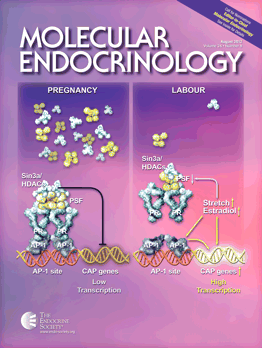Mol Endocrinol:雷公藤红素或能治疗前列腺癌
2012-08-15 Beyond 生物谷
英国癌症研究中心科学家揭示男性雄激素能刺激前列腺癌的生长,研究还发现某些现有的药物具有用来治疗该疾病的前景。经常用激素疗法治疗前列腺癌,靶向雄激素受体(AR),雄激素受体是一个大的蛋白质,能控制细胞分裂信号,并在前列腺癌细胞中过度活跃。 AR依赖与其他一些蛋白质如HSP90和P23相互作用来发挥功效,HSP90和P23相互作用有助于AR折叠成其活性形式。以前认为P23和HSP90一起作用来激活A
英国癌症研究中心科学家揭示男性雄激素能刺激前列腺癌的生长,研究还发现某些现有的药物具有用来治疗该疾病的前景。经常用激素疗法治疗前列腺癌,靶向雄激素受体(AR),雄激素受体是一个大的蛋白质,能控制细胞分裂信号,并在前列腺癌细胞中过度活跃。
AR依赖与其他一些蛋白质如HSP90和P23相互作用来发挥功效,HSP90和P23相互作用有助于AR折叠成其活性形式。以前认为P23和HSP90一起作用来激活AR,但这一最新研究成果显示P23也能独立地不依赖于HSP90来提高AR活性。
最重要的,这意味着,阻断P23可能能有效的治疗对HSP90抑制剂耐受的前列腺,HSP90抑制剂正在实验对乳腺癌和前列腺癌是否有效。该研究结果发表在Molecular Endocrinology杂志上。
早期认为HSP90和P23是相辅相成的,但我们惊奇地发现P23也能提高雄激素受体的活性,即使我们使用了修改过的无法绑定HSP90的形式。阻断P23的药物如雷公藤红素能治疗一些疾病如关节炎、哮喘等,这意味着这项研究的成果已经向临床试验迈进了一步。下一阶段将是在实验室中测试这种药物对前列腺癌细胞的影响。
编译自:Scientists solve key piece of prostate cancer puzzle

doi:10.1210/me.2011-1281
PMC:
PMID:
Allosteric Conversation in the Androgen Receptor Ligand-Binding Domain Surfaces
Solène Grosdidier*, Laia R. Carbó*, Víctor Buzón, Greg Brooke, Phuong Nguyen, John D. Baxter§, Charlotte Bevan, Paul Webb, Eva Estébanez-Perpi?á** and Juan Fernández-Recio**
Androgen receptor (AR) is a major therapeutic target that plays pivotal roles in prostate cancer (PCa) and androgen insensitivity syndromes. We previously proposed that compounds recruited to ligand-binding domain (LBD) surfaces could regulate AR activity in hormone-refractory PCa and discovered several surface modulators of AR function. Surprisingly, the most effective compounds bound preferentially to a surface of unknown function [binding function 3 (BF-3)] instead of the coactivator-binding site [activation function 2 (AF-2)]. Different BF-3 mutations have been identified in PCa or androgen insensitivity syndrome patients, and they can strongly affect AR activity. Further, comparison of AR x-ray structures with and without bound ligands at BF-3 and AF-2 showed structural coupling between both pockets. Here, we combine experimental evidence and molecular dynamic simulations to investigate whether BF-3 mutations affect AR LBD function and dynamics possibly via allosteric conversation between surface sites. Our data indicate that AF-2 conformation is indeed closely coupled to BF-3 and provide mechanistic proof of their structural interconnection. BF-3 mutations may function as allosteric elicitors, probably shifting the AR LBD conformational ensemble toward conformations that alter AF-2 propensity to reorganize into subpockets that accommodate N-terminal domain and coactivator peptides. The induced conformation may result in either increased or decreased AR activity. Activating BF-3 mutations also favor the formation of another pocket (BF-4) in the vicinity of AF-2 and BF-3, which we also previously identified as a hot spot for a small compound. We discuss the possibility that BF-3 may be a protein-docking site that binds to the N-terminal domain and corepressors. AR surface sites are attractive pharmacological targets to develop allosteric modulators that might be alternative lead compounds for drug design.
本网站所有内容来源注明为“梅斯医学”或“MedSci原创”的文字、图片和音视频资料,版权均属于梅斯医学所有。非经授权,任何媒体、网站或个人不得转载,授权转载时须注明来源为“梅斯医学”。其它来源的文章系转载文章,或“梅斯号”自媒体发布的文章,仅系出于传递更多信息之目的,本站仅负责审核内容合规,其内容不代表本站立场,本站不负责内容的准确性和版权。如果存在侵权、或不希望被转载的媒体或个人可与我们联系,我们将立即进行删除处理。
在此留言







